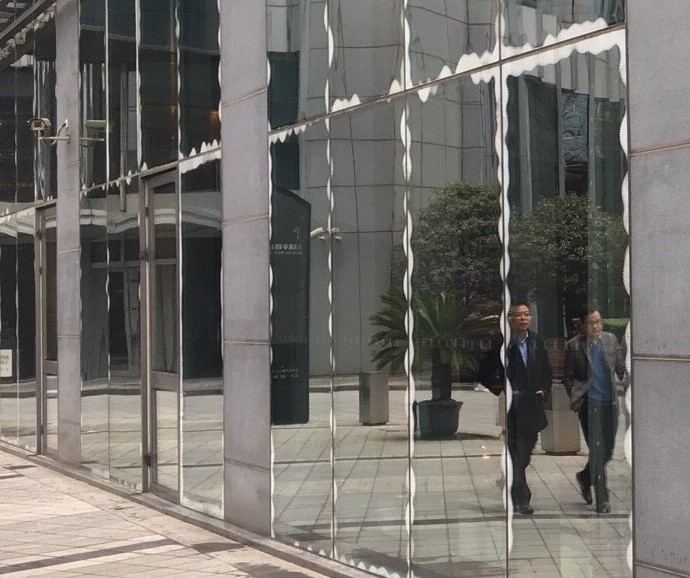This is the façade of an office tower in Shanghai, where I visited a few times along the past years. The delamination in the edges became clearly visible a couple of years ago. It is not possible to figure out the precise cause behind this failure without knowing the process and glass details, but there are a few possible explanations to be considered.
Could These Failures Be Avoided?
A glass unit for this kind of installation is typically insulated glass with tempered laminated glass panes on both sides. The outer pane has coated glass, probably high-performance solar control glass. Cloudy, milky shades on edge can be seen all around of the glass, along the short as well as the long edges. Some points of the glass here had clear bubbles/ air intrusions on the glass edge, which probably could have been detected quite easily already after the autoclaving. It looks like humidity has penetrated into the laminate already. At least the edge sealing during the prepressing failed here. But why?
It could be the wrong settings in lamination process, such as pressing force of the nip rollers, oven temperature, or line speed. The conditioning of the PVB also may have been incorrect prior to assembly. However, those would have caused relatively even defects. Eccentric nip rollers could also be the case, but that would probably have been discovered already during installation tests of the line.
We see that the edge defect in some points is smooth and continuous, whereas some of the long edges have relatively regular, wavy shape. We can also see clear distortions on the reflections of the glass. Let us work a conclusion on this:
These defects probably came along in poor tempering and lack of proper quality control. One very probable root cause could be the deformation of the edges during the tempering process, also called picture frame distortion, or edge distortion in combination with roller waves. These deformations typically lead to poor bond of the PVB (or other foil) to the glass, which may result in air intrusions into the glass during the autoclaving. Sometimes the intrusions are not clearly visible, and the poor adhesion cause delamination years after the installation.
The use of clips or clamps around the glass edges during autoclaving is common trick to tackle similar problems, but tensions remain on the edges, which tend to tear the laminate edges apart along the years. What can be done to avoid these costly failures?
Flatness Is the Key to Improve Yield of Lamination.
The key for successful lamination of tempered glass is flatness. During the tempering process, the glass is heated up above its softening point to 620-640°C, which causes deformations on the glass, when conveyed on the ceramic rollers. Typical deformations of a tempered glass lite include roller waves and edge lift, which are typically measured according to the norms so that faulty glasses are discarded. In addition to these, pocket distortion, picture frame distortion, center kink and bistable glass are sometimes seen after tempering process and important to measure to avoid that these goes further in the process.

If not detected on time, such deformations ruin the optical quality of tempered glass and have severe impact on the downstream operations, such as laminating, and consequently results in costly remakes or replacements at site, as seen here.
The first step to tackle the problem is to measure these deformations with accurate and reliable distortion measurement system. Once measured, the faulty process can be identified, and corrective action can be taken. With optimized process these deformations can be minimized and, in some cases, practically eliminated. In case deformed or bad glass comes out from the tempering furnace, it can be immediately removed from the production line instead of wasting downstream capacity in processing them further. Processing faulty glass further add only waste and cost, not value. It is very important to measure all kind of distortions, not only edge lift and roller wave, as pocket (or hammer) distortion and cross conveyor distortion compromise the quality of the laminate.
As explained above, some fabricators laminating tempered glass regularly use clamps around glass edges during autoclaving. This is time consuming, labor intensive, and not very reliable way to guarantee perfect quality. The experience from several processing plants showed, that clamps were no longer needed after a proper distortion measurement system was installed and tempering recipes adjusted accordingly.
The investment in an accurate, reliable, and versatile distortion measurement system really pays off. This case is only one example of proving this.

Author: Juha Karisola

